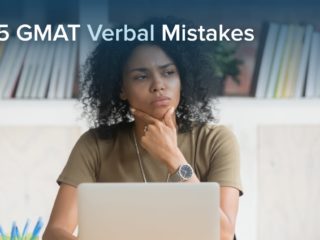Last Updated on November 23, 2023
If you’re studying for the GMAT (Graduate Management Admission Test) for business school, you may be looking for ways to enhance your knowledge retention. After all, there is a LOT of material to learn in order to earn an impressive GMAT score.
So, in this article, we’ll discuss 5 GMAT visual learning strategies you can easily incorporate into your GMAT study plan. Whether you’re a visual learner or just looking for ways to enhance your GMAT prep, these 5 strategies will help make your test preparation more effective and more engaging.
Here are the 5 strategies we’ll discuss:
- Strategy 1: Use Visually Engaging Study Materials
- Strategy 2: Create Flashcards
- Strategy 3: Imagine What You’re Reading in Movie Form
- Strategy 4: Use a GMAT Prep Resource With Video Solutions
- Strategy 5: Attend Webinars or Take Online Classes
- Key Takeaways
- What’s Next?
Let’s get into our strategies!
Strategy 1: Use Visually Engaging Study Materials
The days of having no choice but to study for the GMAT from a 5 lb. book containing hundreds of pages of bland blocks of text are over. There are plenty of alternatives available, including dynamic, visually engaging ones. So, one of the simplest ways you can incorporate visual learning into your GMAT test prep is by choosing visually stimulating study materials.
For example, interactive software such as an online self-study course can be much more visually engaging than a book. Of course, not all online courses are created equal. But, a great one will be designed specifically to make information easier to process and help students actively engage with the material.
Here at TTP, we spent years perfecting both the user interface and structure of our GMAT course to create a study experience that visually and mentally engages students and maximizes knowledge retention. GMAT concepts are presented in bite-size lessons that incorporate diagrams and models and highlight must-know concepts and strategies.
In fact, students can highlight any sentence in a lesson, practice question, or solution as they read, and with the click of a mouse, create a personalized, color-coded note for themselves. Students also have access to a library of videos on everything from strategies for answering specific GMAT question types to taking practice tests to organizing their studies.
These are just a few examples, but the point is preparing for the GMAT can be a genuinely interesting and even fun experience with the right study materials. So, take the time to research what’s available and find a resource that keeps you engaged. Why not start with a 5-day, full-access trial of the TTP course? It’s just $1!
TTP PRO TIP:
Use a GMAT prep resource specifically designed to be visually engaging and make information easier to process.
Strategy 2: Create Flashcards
Flashcards are an excellent tool for visual learners or anyone wishing to make their GMAT prep more engaging. First, they’re completely customizable. So, you can “design” your flashcards to be visually engaging to you, so that key points stand out.
Secondly, by its very nature, a flashcard highlights a particular thing, allowing you to focus on just that thing. When you see a concept or formula in isolation, you’re better able to form a mental image of it. That mental image helps the material stick, making it easier to recall later.
When you’re just reading or even watching videos for a long stretch, your eyes can start to glaze over. The information may wash over you without really sinking in. Flashcards provide a quick hit of information, forcing you to focus on what you’re looking at and stay in the moment.
In fact, note-taking in general is a great way to make your learning more visually engaging and remain an active participant in your studying. Like flashcards, your notes can be personalized to help you focus on concepts you want to highlight and retain information. For example, color-code your notes by writing formulas in green, examples in blue, and any special issues in red. Make the notes your own.
The TTP course includes note-taking tools and hundreds of expertly designed digital flashcards covering key Quant and Verbal concepts and strategies. The course also gives students the ability to create digital flashcards of their own. Our students love being able to easily drill concepts and refresh their knowledge. Additionally, there is a gamification aspect of using flashcards that many students find helpful.
KEY FACT:
Flashcards allow you to focus on one concept or formula in isolation, making it easier to form a mental image of what you’re reading.
Strategy 3: Imagine What You’re Reading in Movie Form
In many instances, it simply won’t be practical or feasible for GMAT material to include visual elements such as graphs and charts or videos and animations. Yet, you still need to be able to stay focused and assimilate text-based information.
For example, GMAT students often find it difficult to stay engaged with passages in Reading Comprehension or Critical Reasoning. Of course, engaging with what you’re reading in a passage is an essential part of mastering Critical Reasoning and Reading Comprehension.
Fortunately, you CAN make the experience of reading passages more visual, and thus more engaging, by picturing what you’re reading. Imagine what you’re reading unfolding as if it’s a movie you’re watching. This visualization process will help you be a more careful reader and better assimilate and connect the information.
Picturing described scenarios isn’t just for Verbal questions; it can also help you assimilate information in Quant word problems. Whatever you’re reading, whether it’s a practice question or lesson, try imagining it in movie form. You may be surprised at how much more easily you’re able to recall what you’ve read.
Alternatively, if you’re reading about something such as a formula, try to create a photograph of it in your mind. For example, say you just learned that rate = distance / time. Rather than merely reading that formula, look at it and create a mental “snapshot” of it. Later on, you can try to conjure up that snapshot in your mind.
TTP PRO TIP:
Imagine what you’re reading unfolding as if it’s a movie you’re watching, or create mental “snapshots” of formulas and concepts you study.
Strategy 4: Use a GMAT Prep Resource With Video Solutions
Video-based learning can certainly enhance your GMAT prep. However, I think GMAT students sometimes overemphasize videos as the be-all and end-all of visual learning. Part of the reason I think this happens is that there are many free, easily accessible GMAT videos online.
In fact, a student could easily create a study plan that revolves around watching videos and not much else. I’ve seen it happen many times. Students exclusively watch free GMAT videos online, and then do a slew of GMAT practice questions. Despite repeating this process over and over — often for long periods of time — they can’t seem to get much closer to being ready for GMAT exam day.
The thing is, it can be just as easy to zone out when watching a video as it is when reading a book. Think about how often we put on Netflix or YouTube and quickly get sidetracked by other things. Seeing something moving on a screen or hearing someone talking does not mean you’re actually processing the information!
Nevertheless, visual learners can incorporate videos into GMAT prep strategically and ensure that the videos they watch promote active engagement. For example, the TTP course provides video solutions to practice questions. In these videos, a TTP GMAT expert walks step-by-step through completion of the problem, illustrating each step, so that students can see the problem solved in real time. Then, students can repeat the process themselves later.
TTP PRO TIP:
Study with a resource that provides video solutions to GMAT practice questions.
Strategy 5: Attend Webinars or Take Online Classes
Another way to incorporate more visual learning into your GMAT prep is by attending webinars or online classes. Webinars and online classes are another opportunity for you to watch a GMAT expert work through GMAT questions and implement GMAT strategies in real time. For instance, in TTP LiveTeach online GMAT classes, the instructor explains strategies and solutions step by step by drawing on an online whiteboard, just as any teacher in a traditional classroom would write on a chalkboard.
Likewise, in our free, weekly Quant and Verbal webinars, TTP expert instructors use an online whiteboard to illustrate problem-solving techniques, highlight key portions of passages, and demonstrate how to solve various question types from beginning to end.
TTP PRO TIP:
Incorporate more visual learning into your GMAT prep by attending webinars or online classes led by GMAT experts.
Key Takeaways
Visual learning for the GMAT isn’t all about intricate infographics or complex cognitive mapping techniques. With a few relatively simple changes to your study routine, you can make visual learning a part of your test preparation. You’ll make your GMAT more engaging and effective in the process!
Here are 5 visual learning strategies to incorporate into your GMAT study plan:
- Use visually engaging study materials.
- Create flashcards.
- Imagine what you’re reading in movie form.
- Use a GMAT prep resource with video solutions.
- Attend webinars or take online classes.
What’s Next?
Looking for more tips to help get you test-day ready? Check out our article on how to increase your accuracy on GMAT questions.
Need to earn an outstanding GMAT score? These strategies for scoring 750 on the GMAT can help.
And if you’re wondering where your Quant and Verbal skills currently stand, try our free GMAT diagnostic test.



